| Type | Aktiebolag |
|---|---|
| Founded | Trollhättan, Sweden (1937) |
| Founder(s) | Svenska Aeroplan Aktiebolaget |
| Headquarters | Trollhättan, Sweden |
| Area served | Worldwide |
| Key people |
Jan-Åke Jonsson (CEO) Victor Muller (Chairman) |
| Industry | Automotive |
| Products | Automobiles |
| Revenue (turnover) | SEK 6.080 billion (2009)[1] |
| Operating income |
|
| Net income |
|
| Employees | 3,355 (2009)[2][3] |
| Parent | Spyker Cars N.V. |
| Website | Saab.com |
Saab Automobile AB, better known as Saab (English pronunciation: /ˈsɑːb/, or SAAB, an acronym for Svenska Aeroplan Aktiebolaget),[4][5] is a Swedish luxury car manufacturer owned by Dutch automobile manufacturer Spyker Cars NV.[6] It is the exclusive automobile Royal Warrant holder as appointed by the King of Sweden.[7] Since its inception, Saab has been known for innovation, pioneering significant advancements in ergonomics, green technology, safety and turbocharging. Originally the automobile manufacturing division of Svenska Aeroplan Aktiebolaget (English: Swedish Airplane Limited), later known as Saab AB, Saab Automobile was acquired by General Motors in 1990 who sold it to Spyker Cars in 2010.
Company history[]
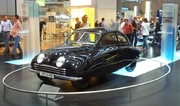
Saab 92001
Saab was originally a division of Svenska Aeroplan Aktiebolaget (English: Swedish Airplane Limited), which had been created in 1937 in Linköping. The company had been established in 1937 for the express purpose of building aircraft for the Swedish Air Force to protect the country’s neutrality as Europe moved closer to war. As the war drew towards a close and the market for fighter planes evaporated, the company began looking for new markets in which to diversify.
Svenska Aeroplan AB (1948–1969)[]

Saab 92
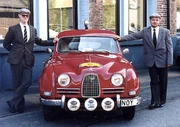
Saab 93B

Saab 96
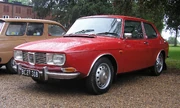
Saab 99
In 1944, Project 92 began, with the goal of creating the first Saab passenger car. The result, the Saab 92001 (or Ursaab), was unveiled three years later, with a design that highlighted the company’s roots in aviation. Notably, the car’s drag coefficient of 0.30 was the lowest of any production car of the time.
Three years into Project 92, a company site in Trollhättan was converted to allow automobile assembly and the project moved there. The company has remained headquartered there since.
In 1949, Saab was ready to bring the car to market, and the Saab 92 went into production, selling 20,000 examples through the mid-1950s.
The 92 was thoroughly redesigned and reengineered in 1955, and accordingly was renamed the Saab 93. The car’s engine gained a cylinder, going from two to three and its front fascia became the first to sport the first incarnation of Saab’s trademark trapezoidal radiator grill. A wagon variant, the Saab 95, was added in 1959.
The decade also saw Saab’s first foray into performance motoring with the Saab 94, the first of the four Saab Sonetts.
1960 saw the third major revision to the 92’s platform in the Saab 96. The 96 was an important model for Saab: it was the first Saab to be widely exported out of Sweden. It proved very popular, selling nearly 550,000 examples.
Even more important to the company’s fortunes was 1968’s Saab 99. The 99 was the first all-new Saab in 19 years, and unlike its predecessors, severed all ties with the 92. The 99 had many innovations and features that would come to define Saabs for decades: wraparound windscreen, self-repairing bumpers, headlamp washers and side-impact door beams.
The design by Sixten Sason was no less revolutionary than the underlying technology, and elements like the Saab "hockey stick" profile graphic continue to influence Saab design.
Saab-Scania (1969–1989)[]
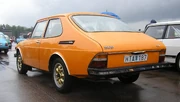
Saab 99
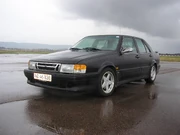
Saab 9000

Saab 900
In 1969, Saab merged with the Swedish commercial vehicle manufacturer Scania-Vabis AB to form Saab-Scania AB.
The 99 range was expanded in 1973 with the addition of a combi coupe model, a body style which quickly became synonymous with Saab. Owing to its great success, the millionth Saab was produced in 1976.
Saab entered into an agreement with Fiat in 1978 to sell a rebadged Lancia Delta as the Saab 600 and jointly develop a new platform. The agreement yielded 1985’s Saab 9000, sister to the Alfa Romeo 164, Fiat Croma and Lancia Thema; all rode atop a common Type Four chassis. The 9000 was Saab’s first proper luxury car.
1978 also was the first year for the 99’s intended replacement: the Saab 900. Nearly one million 900s would be produced, making it Saab’s best-selling model. A popular convertible version followed in 1986, all of which were made at the Saab-Valmet factory in Finland, making up nearly 20% of 900 sales. Even today, the "classic 900" retains a cult following among enthusiasts.
General Motors ownership (1989–2010)[]

Saab 900
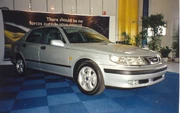
Saab 9-5

Saab 9-3 sport combi

Saab Aero-X
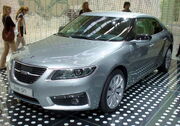
second generation Saab 9-5

second generation Saab 9-5
In 1989, the Saab car division of Saab-Scania was restructured into an independent company, Saab Automobile AB, headquartered in Sweden; General Motors and Investor AB controlled 50% each. GM’s investment of US $600 million gave them the option to acquire the remaining shares within a decade.
GM’s involvement spurred the launch of a new 900 in 1994. The new car shared a platform with the Opel Vectra. Due in large part to its success, Saab earned a profit in 1995 for the first time in seven years. However, the model never achieved the cult following of the "classic 900" and did not achieve the same reputation for quality.
1997 marked Saab’s 50th anniversary as an automaker. The company used their jubilee owner’s convention to launch a replacement for the aging 9000: the Saab 9-5. The 900 received a facelift and renaming complimentary to its new larger sibling: it would now be called the Saab 9-3. The 9-5 was the first Saab without a combi coupe bodystyle option in twenty years. Filling that space was a wagon variant, introduced in 1999.
GM exercised their option to acquire the remaining Saab shares in 2000, spending US $125 million to the turn the company into a wholly owned subsidiary.
The newly close relationship yielded its first product in 2003’s all-new 9-3. The new model, marketed as a sport sedan, dropped Saab’s iconic hatchback in favor of a more conventional four-door approach. The model shared a platform and components with the Vectra again, but the relationship was much closer than had been in the past.
Under GM’s direction, the badge-engineered Saab 9-2X (based on the Subaru Impreza) and Saab 9-7X (based on the Chevrolet Trailblazer) were introduced in the American market in 2005 with the hope of increase sales. Both models were a critical and commercial failure and were scrapped a few years after production. GM also delayed the 9-3 wagon by three years, canceled a 9-5 replacement in 2005 and announced a planned shift of production away from Saab’s historic home in Trollhättan to Opel’s factory in Rüsselsheim.
Owing to fading fortunes across their entire business, GM announced that the Saab brand was "under review" in December 2008, a process which included the possibility of selling or shuttering the carmaker. Reportedly, 27 potential buyers emerged, including BMW, Fiat, Geely, Hyundai, Magna, Renault and Tata Motors; serious talks progressed with three bidders: Koenigsegg, Merbanco and Renco Group.
As the talks progressed, GM’s support receded, and the company went into administration, the Swedish equivalent of America’s Chapter 11 bankruptcy. Saab’s managing director Jan-Åke Jonsson said that this was "the best way to create a truly independent entity that is ready for investment".[8] For its part, the Swedish government was reluctant to become involved, with Maud Olofsson, industry minister, saying: "The Swedish state and taxpayers in Sweden will not own car factories. Sometimes you get the impression that this is a small, small company but it is the world’s biggest automaker so we have a right to make demands."[9]
On June 16, 2009, Koenigsegg, the Swedish supercar maker, announced their intentions to purchase the brand from GM.[8] The bid was backed by a group of Norwegian investors and the Chinese carmaker BAIC. The following month, both parties announced that GM had consented to the deal. There were outstanding financial details, but a loan from the European Investment Bank was expected to cover them. The loan was approved in October, but on November 24, Koenigsegg announced that it had "come to the painful and difficult conclusion that it could no longer carry out the acquisition."[10]
It was announced on December 14 that the Chinese automaker would acquire the intellectual property rights and production equipment for the previous generation Saab 9-3 and Saab 9-5 in a deal worth about US$197 million, which was enough for the company to run for three months.[11][12] BAIC has expressed their intent to create a new brand around the purchased technology and admitted to the purchase of "three overall vehicle platforms, two engine technologies and two transmission systems."[13]
Following the collapse of talks with Koenigsegg, GM announced that the brand would be eliminated in 2010 if it failed to secure a buyer before the close of 2009.[14] As talks with several firms failed, including the Netherlands-based boutique supercar maker Spyker, GM formally announced their intention to wind down the Saab brand.[14]
Undeterred, a new offer round materialized. Earlier bidders Spyker and Merbanco revised offers and were joined by a submission from Luxembourg-based Genii Capital, who boasted the support of F1 chief Bernie Ecclestone.[14] GM continued accepting bids until a self-imposed deadline of January 7, 2010. Acknowledging that the chances for reaching a deal with any party were very slim, they pledged to evaluate each offer with due diligence.[15][16]
Spyker ownership (2010-present)[]
On January 26, 2010, General Motors confirmed that Spyker and General Motors had come to an agreement allowing Spyker to purchase Saab,[17] subject to regulatory and government approval; the sale was completed on February 23, 2010.[18] General Motors will continue to supply Saab with engines, transmissions and also completed vehicles in the shape of the new Saab 9-4x from GM's Mexican factory.[17] The deal includes a loan from the European Investment Bank, guaranteed by the Swedish government. It comprises $74m in cash up front, payable to GM by July 2010, and shares in Spyker to the tune of $320m (US).
Saab announced that it was going to build its US headquarters in Royal Oak, Michigan.[19] A new Saab 9-3 was confirmed for 2012,[20] while production restarted at the Saab plant in Sweden in March 2010.[21] Victor Muller, CEO and founder of Spyker Cars stated in an interview that the take-over was financed solely by Vladimir Antonov with the knowledge of General Motors.[22]
In October 2010, the Company revised its production target for the year to 30,000 to 35,000 vehicles from 45,000 vehicles as a result of longer time was needed to recover from plant shutdown for two months at the beginning of the year and reverse liquidation proceeding. It was reported that it was the second time forecast was cut in less than three months.[23] In July 2010, the Company expected to sell between 50,000 to 55,000 vehicles in 2010.[24] As part of its expansion programme Saab announced plans to return to China after General Motors withdrew from the Chinese market in 2008 due to the global financial meltdown, Saab plan to sell between 2,000 and 5,000 cars initially and should reception of the vehicle go well they plan to move production to China as well, the deal will see 10 dealerships opened. The deal will be signed with China Automobile Trading Co. Ltd.[25]
On February 25, Spyker Cars N.V. announced they had agreed to sell the sports car arm to focus on Saab.[26] They intend to change their name in May to include Saab.[27]
Production[]

Saab's main production facilities in Trollhättan
Saab's total world production in 2008 was 90,281 vehicles produced in 3 countries.[28][29]
| Country | Cars (2010) | Cars (2009) | Cars (2008) | Cars (2007) | Models |
|---|---|---|---|---|---|
| Sweden Trollhättan |
32,048 | 20,950[29] | 75,073 | 102,915 | 9-3 Sedan, Wagon, and Convertible, 9-5 Sedan and Wagon |
| Mexico Ramos Arizpe |
0 | 98[30] | 0 | 0 | 9-4x (Q2 2011) |
| Total | 32,048 | 20,905 | 89,086 | 125,397 |
Saab manufactured various models at the Valmet Automotive plant in Uusikaupunki, Finland, between 1969 and 2003, in a joint-venture established in 1968 together with Valmet. Since 2003, Saab no longer manufactures any cars in Finland as the production of the 9-3 Convertible was moved to Graz, Austria. In 2010 production of the 9-3 Convertible was moved to Trollhättan. This marked the first time that the Trollhättan facility manufactures the 9-3 Convertible.
Models[]
A common feature of Saab car types is the use of the number 9 in the model numbers. Current models are the 9-3 and 9-5, both of which are manufactured in Trollhättan, Sweden. Until 2008, the 9-7X was manufactured by General Motors along with the Chevrolet Trailblazer and its platform-mates. The exception to this naming rule is the Saab-Lancia 600, which was a rebadged Lancia Delta.
Current models[]
- Saab 9-3 SportSedan (2002–present) second generation
- Saab 9-3 Convertible (2004–present) second generation
- Saab 9-3 SportCombi (2006–present) second generation
- Saab 9-3X (2009–present)
- Saab 9-5 Sedan (2010–present) second generation
Future models[]
- Saab 9-4X (new model, planned release in May 2011)
- Saab 9-5 SportCombi (second generation, planned release in July 2011)
- Saab 9-3 (3rd Generation, planned for October 2012)
- Small tear-drop shaped car, codename "92". Inspired by the classic Saab 92.
Historical models[]
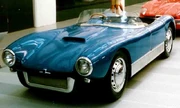
1956 Saab Sonett I
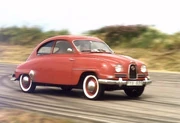
1959 Saab 93
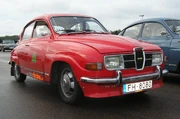
1975 Saab 96
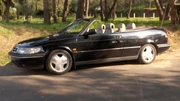
1995 Saab 900SE NG convertible
- Saab 92 and descendants:
- Saab 92 (1949–1956)
- Saab 93 (1955–1960)
- Saab GT750 (1958–1960)
- Saab 94 Sonett I (1956)
- Saab 95 estate car (1959–1978)
- Saab 95 3 cylinder two-stroke (1960–1967)
- Saab 95 V4 (1967–1980)
- Saab 96 (1960–1980)
- Saab 96 3 cylinder two-stroke (1960–1968)
- Saab Sport 3 cylinder two-stroke (1962–1966)
- Saab Monte Carlo 850 3 cylinder two-stroke (1966–1967)
- Saab 96 V4 (1967–1980)
- Saab Monte Carlo V4 V4 (1967–1968)
- Saab 97
- Sonett II (1966–1970)
- Sonett III (1970–1974)
- Saab Formula Junior single seat racing car (1960)
- SAABO caravan/camper/travel trailer (1964–1968)
- Saab 99 and descendents:
- Saab 99 (1968–1984)
- Saab 900 "Classic" (1979–1994)
- Saab 90 (1984–1987)
- Saab 600 (1985–1988)
- Saab 9000 (1985–1998)
- Saab 900 "New Generation" (1994–1998)
- Saab 9-3 first generation (1998–2002)
- Saab 9-2X (2005–2006)
- Saab 9-7X (2005–2009)
- Saab 9-5 first generation (1997–2009)
Concepts and prototypes[]
- Saab 92 line:
- Saab 92001 or Ursaab the prototype for the first Saab production car (1946)
- Saab Monster (1959)
- Saab 60 (1962)
- Saab Quantum (1962)
- Saab Catherina (1964)
- Saab MFI13 (1965)
- Saab Toad (1966)
- Saab 98 (1974)
- Saab EV-1 (1985)
- Saab 9000 Cabriolet
- Saab 9XX Concept (1991)
- Saab 9-X (2001)
- Saab 9-3X (2002)
- Saab 9-3 SportHatch (2003)
- Saab 9-5 Aero BioPower (2006)
- Saab Aero-X (2006)
- Saab 9-4X BioPower (2008)
- Saab 9-X Biohybrid (2008)
- Saab 9-X Air (2008)
- Saab 9-3 ePower sport wagon (2010)
- Saab PhoeniX (2011)
Innovations[]
- 1958: The GT 750 is the first car fitted with seatbelts as standard.[31]
- 1963: Saab becomes the first volume maker to offer diagonally-split dual brake circuits.
- 1969: Saab creates an ignition system near the gearstick - instead of behind the steering wheel like most cars - in an attempt to reduce the very common serious and permanent knee injuries during collisions, caused by the knee impacting the key.
- 1970: Saab introduces a world-first - headlamp wipers and washers.
- 1971: Heated front seats are introduced, the first time in the world they are fitted as standard.
- 1971: Saab develops the impact-absorbing, self-repairing bumper.
- 1976: Saab was the first manufacturer to produce a turbo engine with wastegate to control boost.
- 1978: Saab introduces another 'world-first,' the passenger compartment air filter (pollen filter).
- 1980: Saab introduces Automatic Performance Control (APC), and an anti-knock sensor that allowed higher fuel economy and the use of lower grade fuel without engine damage.
- 1981: Saab introduces the split-field side mirror. This reduces the drivers blind spot.
- 1982: Saab introduces asbestos-free brake pads.
- 1983: Saab introduces the 16-valve turbocharged engine
- 1985: Saab pioneers direct ignition, eliminating the distributor and spark plug wires.
- 1991: Saab introduces a 'light-pressure' turbo.
- 1991: Saab is the first manufacturer to offer CFC-free air-conditioning.
- 1991: Saab develops its 'Trionic' engine management system, equipped with a 32-bit micro-processor.
- 1993: Saab introduces the 'Sensonic clutch' and the 'Black Panel', later to be called the 'Night Panel'.
- 1993: Saab develops the 'Safeseat' rear passenger protection system.
- 1994: Saab introduces the 'Trionic T5.5' engine management system, its processor is a Motorola 68332.
- 1995: Saab presents an asymmetrically turbocharged V6 at the Motor Show in Frankfurt am Main, Germany.
- 1996: Saab introduces active head restraints (SAHR), which help minimize the risk of whiplash.
- 1997: Saab introduces Electronic Brake-force Distribution
- 1997: Saab fits ventilated front seats to their new 9-5.
- 1997: Saab introduces ComSense; an alert delay feature that reduces the risk of distraction by briefly postponing lower priority alerts when the brakes or indicators are activated
- 2000: Saab introduces SVC; a Variable Compression, an engine in which the compression ratio is varied by tilting the cylinder head in relation to the pistons.
- 2002: Saab developed ReAxs System provides crisp steering feedback and contributes to enhanced driving stability in curves
- 2003: Saab introduces CargoSET; automatic storage well retraction for the convertible, a two-step tonneau action for quicker soft-top deployment
- 2008: Saab introduces Cross-wheel drive, an advanced all-wheel drive system with eLSD.
Safety[]
Safety has a high priority in the design of Saab cars. The cars are subjected to the elk test as elk are a common cause of accidents in Sweden. Saab have compiled a database containing over 6,100 real-life accidents with Saabs. The first recorded event was in 1948 where Julian Shermis had an accident.[32]
All modern Saabs (except the 9000 and 9-2X) have a floor-mounted ignition. This is for many reasons, some of which follow: Saab believes this is a safer position in case of an accident. The driver's knee often jerks upward in a collision; the compact and dense ignition module on the steering column of many other cars has shattered many kneecaps. Saabs have bolstered dashboards for both front seat occupants. Also, the floor-mounted position yields more space, allowing modern Saabs to have a metal bar that rotates over and up into the ignition when the key is turned to the "Lock" position. This makes Saabs very challenging to hotwire. Ergonomically, the ignition's location next to the parking brake lever, gearshift, and seatbelt, saves time. Last of all, the ignition is located on the floor because, in the aircraft that inspired Saab automobiles, the throttle controls were all located on the floor. Originally Saabs also had the key located on the right side of the steering column, but when they changed from a column shifter to a floor shifter, the ignition key followed along, except in the Sonett III and 9000.
Endurance records[]
In October 1986 the Saab Long Run took place. Three standard Saab 9000 Turbos set 2 world records and 21 international records at the Talladega Superspeedway in Talladega, Alabama, USA. 100,000 km (62,137 miles) were covered with an average speed of 213.299 km/h (132.537 mph) and 50,000 miles (80,467 km) with an average speed of 213.686 km/h (132.778 mph).
Ten years later, in 1996, three standard Saab 900 (NG) Turbos driven by factory test drivers and two standard naturally aspirated Saab 900s driven by journalists set new world records on the same speedway.
In early December 2006, a Wisconsin traveling salesman donated his 1989 Saab 900 SPG (Special Performance Group) to the Wisconsin Automotive Museum after amassing 1,001,385 miles (1,611,573 km) on the original factory engine. This mileage was verified by Saab.[33]
Marketing and ownership[]
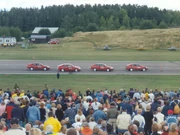
Saab Performance Team at Linköping, in 1997 (Saab 91 Safirs in background)
Dating back to 1937, Svenska Aeroplan AB (SAAB) created airplanes, introducing their first car, the Saab 92001, in 1947. Currently, Saab AB is separate from Saab Automobile (which is owned by Spyker Cars), and is probably best known for its Saab 37 Viggen (the Viggen badge would be shared by a 9-3). This has led to a ad campaign, "Born From Jets," evoking the days when Saab produced both aircraft and automobiles. Saab is imported into many countries. Each company has a president to the subsidiary or importer. In the case of the U.S., the first president was Mr. R. Millet.
In 1987, Saab created a TV advertisement called "Saab suite" (subtitled Ballet in 3 acts for 8 Saab 9000 Turbos). In the film, stunt drivers show incredible driving with stock cars, such as one-wheeled burnouts, bumper-to-bumper driving through a slalom, cars slaloming from opposite directions on the same course, two-wheel driving, sliding in full speed, and jumping over passing cars—all on a closed airport runway with classical music playing in the background. Click Here to view the video.
To commemorate its 40th anniversary, Saab formed a Performance Team in 1987, which laid on exhibitions of automobile acrobatics and formation driving. Initially this was done with Saab 9000s, as above, then later models, such as the Saab 900 (NG) were used. All of the team's members have previously competed in rallies, but what's unusual is that all 5 Performance Team members hold regular jobs at Saab: there are two engineers, a quality controller, a technician and the head of Saab's photo studio. The picture shows these vehicles on display at the Diamond Jubilee celebrations of the Saab Aircraft Company, at Linköping, in 1997. Click here to view one of their videos
A Hewlett-Packard CPU-support chip features a Saab 900 Turbo 16 Cabriolet etched into its structure.[34]
Ownership and brand loyalty[]
As the brand has an unusual image in most markets, Saab owners tend to be correspondingly offbeat: intellectuals and enthusiasts.[35][36] In his studies of brand communities, Albert Muniz, professor of marketing at DePaul University in Chicago, found significant characteristics of Saab owners which he called Snaabery.[37] These included ownership of an original, pre-GM Saab; camaraderie with other Saab drivers and contempt for other brands such as BMW. Writer John Crace characterised the typical "Snaab" as a creative advertising executive with large spectacles and an asymmetric hairstyle.[38] Rüdiger Hossiep, a psychologist at Ruhr University Bochum, found that Saab drivers have the highest level of psychological involvement with their cars, being over 10 times more passionate than the average Volkswagen driver.[37] Saab's main three markets are Sweden, the United Kingdom and the United States.[38]
Slogans[]
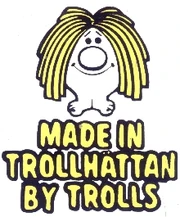
Saab Made in Trollhattan by Trolls sticker, 1970s
- Built by Trolls in Trollhatan (Decal - 1960s/70s Works 96 Rally Cars - side windows)[39]
- Go Swift - Go Safe - Go Saab (Advertisement Page - 1970s FIA Year Book)[40]
- The most intelligent cars ever built. (1980s)[41]
- Find your own road. (1990s)[42]
- Welcome to the State of Independence (early 2000s; United States)[42]
- Born From Jets. (2007–09; United States, Canada)[42]
- Move Your Mind. (Current Global Slogan)
- People Who Test Drive a SAAB, Usually Buy One[42]
- We don’t make compromises. We make Saabs.[42]
- Saab. It's what a car should be.[42]
- The Command Performance Car.[42]
- The Well-Built Swede[43]
Literature and the arts[]
The Saab 900 Turbo was James Bond's vehicle of choice in many of the John Gardner Bond novels of the 1980s, beginning with Licence Renewed. In the second novel, For Special Services, the 900 was dubbed the "Silver Beast".[44] The car is Bond's private vehicle that he had outfitted with various gadgets by the real-life company Communication Control Systems, Ltd. (CCS). In conjunction with the release of Licence Renewed, Saab had a real "Silver Beast" created that was virtually identical to the specifications in the book. The car is currently located at the Saab Museum in Trollhättan, Sweden.
In an essay originally published in In These Times in November, 2004 entitled Have I Got A Car For You, writer Kurt Vonnegut recounts his experiences as the owner/operator of a Saab dealership in West Barnstable, Massachusetts and humorously claims that his criticism of Swedish engineering is the reason he was never awarded a Nobel Prize in Literature. The essay also appeared in the 2005 anthology A Man Without A Country.
See also[]
- Saab, airplanes.
- Talbot Horizon - This vehicle replaced the Saab 96 on the Valmet line and used many of the same parts, especially in the interior
- Saab Turbo Mobil Challenge
- Barber Saab Pro Series
- Trionic 8
- Saab hockey stick
- Saab XWD
- Spyker Cars
- Saab Spyker Automobiles
References[]
- ↑ 1.0 1.1 1.2 "Bokslut & Nyckeltal - SAAB Automobile Aktiebolag". Allabolag. Retrieved on 2010-08-13.
- ↑ "Saab Data Sheet". Saab Automobile AB. Retrieved on 2010-08-31.
- ↑ "Factbox - Key facts about Saab", Reuters (2009-05-19). Retrieved on 2009-05-19.
- ↑ "Saab | History and Background: Timeline, Video". Saabusa.com (1980-01-01). Retrieved on 2009-02-11.
- ↑ "The History of Svenska Aeroplan Aktiebolaget or SAAB". Retrieved on 2010-01-30.
- ↑ Spyker Cars N.V. (2010-02-23). "Spyker Cars finalizes the purchase of Saab" (PDF), http://www.spykercars.nl/download/investor/closure_SAAB_Feb_230210_final.pdf.
- ↑ "Saab Automobile AB by appointment to His Majesty the King of Sweden". Trollhattan Saab (2008-02-01).
- ↑ 8.0 8.1 "Saab requests creditor protection", BBC (2009-02-20). Retrieved on 2009-02-20. Cite error: Invalid
<ref>tag; name "BBC" defined multiple times with different content - ↑ Pagnamenta, Robin (2009-02-18). "Saab may go bust in 10 days, warns GM", Times Online (London). Retrieved on 2009-02-18.
- ↑ "Saabaffären avbryts | Dagens Nyheter". dn.se. Retrieved on 2009-11-24.
- ↑ Schwartz, Nelson D. (2009-12-14). "Chinese Company Seeks to Make Old Saab Models", nytimes.com. Retrieved on 2010-01-28.
- ↑ "BAIC paid $197 mln for Saab assets - paper", www.reuters.com (2009-12-14). Retrieved on 2010-01-28.
- ↑ "UPDATE 3-BAIC in overdrive to develop brand with Saab tech", Reuters (2009-12-10). Retrieved on 2009-12-23.
- ↑ 14.0 14.1 14.2 "/ Companies / Automobiles - Dutch sports car maker in Saab talks". Ft.com. Retrieved on 2009-12-05. Cite error: Invalid
<ref>tag; name "autogenerated1" defined multiple times with different content Cite error: Invalid<ref>tag; name "autogenerated1" defined multiple times with different content - ↑ "Spyker makes a new offer for Saab; General Motors will evaluate". Autoweek.com. Retrieved on 2009-12-28.
- ↑ "Saab wind-up begins, GM still reviewing bids", reuters.com (2010-01-08). Retrieved on 2010-01-09.
- ↑ 17.0 17.1 "Spyker buys Saab". autocar.co.uk. Retrieved on 2010-01-26. Cite error: Invalid
<ref>tag; name "Autocar.co.uk" defined multiple times with different content - ↑ "Spyker Cars finalizes the purchase of Saab". SaabsUnited.com. Retrieved on 2010-02-23.
- ↑ By KATHY BARKS HOFFMAN (AP) – 6 days ago. "The Associated Press: Saab to locate North American HQ in Royal Oak". Google.com. Retrieved on 2010-03-22.
- ↑ 02 February 2010 (2010-02-02). "New Saab 9-3 confirmed for 2012". Autocar.co.uk. Retrieved on 2010-03-22.
- ↑ 22 March 2010. "Saab production resumes". Autocar.co.uk. Retrieved on 2010-03-22.
- ↑ NRC Handelsblad 22 May 2010, page 17 English translation"[..]Antonov financed me for hundred percent. I borrowed from him $74 million that we had to pay in cash to GM for the acquisition. The Americans knew about this too.", Dutch original:"[..]Antonov heeft mij voor honderd procent gefinancierd. Ik leende van hem de 74 miljoen dollar die wij voor de overname contant aan GM moesten betalen. Dat wisten de Amerikanen overigens ook."
- ↑ Ola Kinnander (2010-10-29). "Spyker Drops as Saab Production Goal Cut, Loss Widens".
- ↑ Johan Nylander (2010-07-28). "Swedish carmaker Saab swings to profit", The Swedish Wire.
- ↑ 10:55 AM ET. "Saab Auto Signs Deal to Re-enter China; Spyker Soars". Bloomberg. Retrieved on 2010-12-20.
- ↑ http://www.freep.com/article/20110225/BUSINESS01/102250396/Spyker-sell-its-sports-car-arm
- ↑ Kinnander, Ola. "Spyker to Sell Sports-Car Unit to Vladimir Antonov in Focus on Saab Brand". Bloomberg.com. Retrieved on 8 March 2011.
- ↑ "WORLD MOTOR VEHICLE PRODUCTION" (PDF). oica.net. Retrieved on 2009-12-19.
- ↑ 29.0 29.1 "Saab Company Snapshot 2009". saabsunited.com. Retrieved on 2009-12-19. Cite error: Invalid
<ref>tag; name "saabsunited.com" defined multiple times with different content - ↑ "Saab starts 9-4x production". Thecarconnection.com (2010-01-25). Retrieved on 2010-12-20.
- ↑ "Saab Innovations". Saab Museum. Retrieved on 2009-06-19.
- ↑ "Saab". Saab Sverige. Retrieved on 2009-08-01.
- ↑ "This Saab story is one in a million". jsonline.com. Retrieved on 2009-12-18.
- ↑ "Saab 900 Turbo 16 Cabriolet". microscopy.fsu.edu. Retrieved on 2009-12-19.
- ↑
- ↑
- ↑ 37.0 37.1
- ↑ 38.0 38.1
- ↑ Patton, Phil. "Gothenburg on the Hudson". New York Times. Retrieved on 8 March 2011.
- ↑ "Go Swift - Go Safe - Go SAAB".
- ↑ "w.saabhistory.com/2006/10/11/saab-advertising-campaign-the-most-intelligent-cars-ever-built/ Saab Advertising Campaign – "The Most Intelligent Cars Ever Built"" (2006-10-11). Retrieved on 2010-01-04.
- ↑ 42.0 42.1 42.2 42.3 42.4 42.5 42.6 Emge, Ryan. "Saab Advertising Campaigns Yesterday & Today". Saab History. Retrieved on 8 March 2011.
- ↑
- ↑ ""THE SILVER BEAST" The Definitive History of James Bond's Saab 900 Turbo". commanderbond.net. Retrieved on 2009-12-19.
External links[]
- Official website
- Saab's heritage and history
- Saab's innovations
- Saabs United (enthusiast blog)
- Saab history (enthusiast blog)
- SaabWorld (Saab forum)
- Saab at the Open Directory Project
| |||||||||||||||||||||||||||||
| Saab, road car timeline, 1950–1979 — next » | ||||||||||||||||||||||||||||||
|---|---|---|---|---|---|---|---|---|---|---|---|---|---|---|---|---|---|---|---|---|---|---|---|---|---|---|---|---|---|---|
| Type | 1950s | 1960s | 1970s | |||||||||||||||||||||||||||
| 0 | 1 | 2 | 3 | 4 | 5 | 6 | 7 | 8 | 9 | 0 | 1 | 2 | 3 | 4 | 5 | 6 | 7 | 8 | 9 | 0 | 1 | 2 | 3 | 4 | 5 | 6 | 7 | 8 | 9 | |
| Compact | 92 | 93 | 95/96 | |||||||||||||||||||||||||||
| 99 | ||||||||||||||||||||||||||||||
| Mid-size | 900 | |||||||||||||||||||||||||||||
| GT | GT | Sport | ||||||||||||||||||||||||||||
| Sport | 94 | 97/Sonett | ||||||||||||||||||||||||||||
| « previous — Saab, road car timeline, 1980s–present | |||||||||||||||||||||||||||||||
|---|---|---|---|---|---|---|---|---|---|---|---|---|---|---|---|---|---|---|---|---|---|---|---|---|---|---|---|---|---|---|---|
| Type | 1980s | 1990s | 2000s | 2010s | |||||||||||||||||||||||||||
| 0 | 1 | 2 | 3 | 4 | 5 | 6 | 7 | 8 | 9 | 0 | 1 | 2 | 3 | 4 | 5 | 6 | 7 | 8 | 9 | 0 | 1 | 2 | 3 | 4 | 5 | 6 | 7 | 8 | 9 | 0 | |
| Compact | 600* | ||||||||||||||||||||||||||||||
| 99 | 90 | 9-2X | |||||||||||||||||||||||||||||
| Mid-size | 900 | 900 | 9-3 | 9-3 | |||||||||||||||||||||||||||
| Convertible | 900 | 900 | 9-3 | 9-3 | |||||||||||||||||||||||||||
| Executive | 9000 | 9-5 | 9-5 | ||||||||||||||||||||||||||||
| SUV | 9-7X | 9-4X | |||||||||||||||||||||||||||||
| *Rebadged Lancia model | |||||||||||||||||||||||||||||||
| ||||||||
| ||||||||||
| This page uses some content from Wikipedia. The original article was at Saab Automobile. The list of authors can be seen in the page history. As with Tractor & Construction Plant Wiki, the text of Wikipedia is available under the Creative Commons by Attribution License and/or GNU Free Documentation License. Please check page history for when the original article was copied to Wikia |
